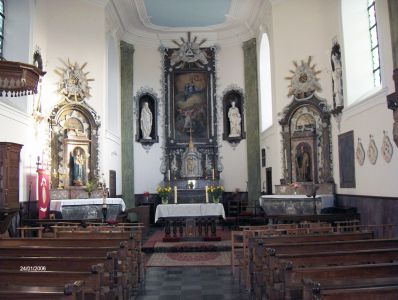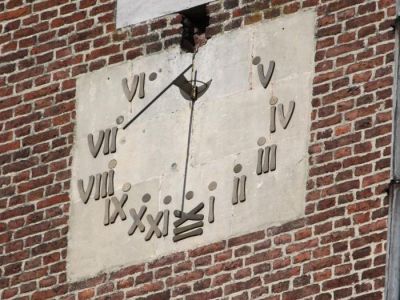Church | 1779 | Baroque, Neoclassical | Catholic Church



Map
Opening hours
01 April - 31 October
Mon -
Tue -
Wed -
Thu -
Fri -
Sat -
Sun 9.00 - 18.00
01 November - 31 March
Mon -
Tue -
Wed -
Thu -
Fri -
Sat -
Sun 9.00 - 16.30
Auch an Feiertagen geöffnet.
Religious offices
Description
Most churches are in the heart of the village. This is not the case here. This one is on a hill, near a small square shaded by chestnut trees, surrounded by the cemetery, the old presbytery and a few houses, a peaceful country setting, at the crossroads of the Mosan and Hesbion landscapes.
The modest brick and limestone building was completed in 1783 after four years of reconstruction work initiated by the chapter of Saint Lambert cathedral in Liège, following the destruction caused by wars and the passage of Louis XIV's troops. On the outside, the massive tower and its sundial, renovated in 2006, are noteworthy.
Inside, there is a nave with three bays. The choir is decorated with stucco representing garlands, cherubs and vines in the Louis XVI style. Above the altar is a painting "The Assumption of the Virgin" (1783) by Jean-Joseph Hanson, painter of the Saint Lambert cathedral in Liège.
The interior decoration benefited, at the time of the reconstruction, from the donations of the Dukes of Arenberg, owners until 1918 of the neighbouring castle of Hautepenne. Their coat of arms is represented at the bottom of the side altars.
Also noteworthy are the pulpit (1665), the baptismal font, a tombstone of Marie de Gavre (1565) and, surrounded by numerous ex-votos, the statue of Saint Vitus, whose relics have been the source of a pilgrimage for more than a century...
KIKIRPA : photo-library online
Photos
Remarkable elements
Major altarpiece with tabernacle and exhibition throne
Style: Louis XVI (circa 1780)
Materials: marble, wood, stucco
Technique: carved (stone), marbled, mounted, sculpted, polychromed
Iconography: Mystical delta with eye of God, glory of cherubs, chalice with Host, garlands, ears of corn, vines and grapes, acanthus leaves, trophy of liturgical objects, Sacred Heart, crucifix
Altarpiece decorated with a painted canvas of the Assumption of the Virgin dated 1783, work of Jean-Joseph Hanson, official painter of the cathedral St Lambert of Liege.
Two beautiful matching confessionals
Style: Louis XIV, Liège school (1726-1750)
Materials: oak
Technique: mounted and carved
Iconographic subject: garlands of flowers, acanthus leaves
Two matching side altars
Style: Louis XVI (around 1780)
Materials: marble, wood, stucco
Technique: carved (stone), marbled, mounted, sculpted, polychromed
Iconography:
- Left side: Monogram of Mary, flowers, leaves; niche decorated with a Spanish-style statue of the Virgin and Child
Crown and sceptre in silver-brass, embossed and chased, hallmarked 1831-1865 (Liège, Joseph Lambotte)
- Right side: Monogram of St Leonard; flowers, leaves; niche decorated with a statue of St Leonard de Noblac (terracotta by Léopold Harzé, 1858, in proof of the Héna coal mine in Awirs.
Coat of arms (white marble): Arenberg and Brancas
Two bells
Date: 1620 and 1621
Materials: cast bronze
Iconography:
The first, "Cécile" (d:80cm;h:66cm) is decorated with a scroll and an inscription with a double chronogram indicating the date of 1620, with two calvaries, a unicorn in a medallion, a pelican and a coat of arms
The second, 'Mary' (d:66cm; h:57cm) is decorated with foliage, a border with an inscription stating that it was cast by Henri Grongnart in 1621 and two medallions (crucifixion and St Francis of Assisi).
Pulpit
Style: Renaissance (1665)
Inscription: engraved date 1665
Materials: oak, paint
Technique: mounted, carved, painted
Baptismal font
Style: Romanesque, Gothic
Materials: base and shaft (1100-1200); stone basin (1501-1600); lid of beaten brass (1801-1900)
Technique: carved



























